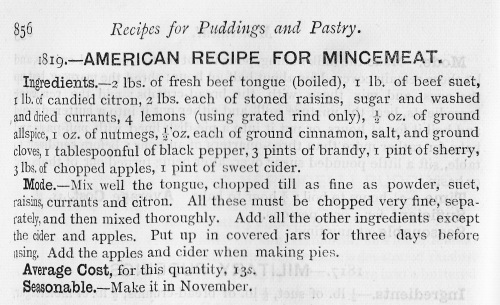September is a good time to be making fruit mince. Not only will you feel really good because you have started planning for Christmas (!) but you will be rewarded with a much better product when you come to use it in a few months time.
Growing up we always called fruit mince mincemeat, but in recent years it seems that fruit mince has taken over as the preferred name, probably to avoid confusion. Fruit mince did originally contain diced or finely chopped meat, often beef. Very early recipes included a mixture of meat and fruit and vinegar or wine which was then used as a pie filling.
My 1888 edition of Mrs Beeton’s Book of Household Management includes a number of mincemeat recipes. This American Recipe for Mincemeat includes boiled beef tongue as well as beef suet. By this stage distilled spirits such as brandy had replaced the vinegar or wine as the preserving liquid and sugar was added to make it more of a sweet dish than a savoury one.
It probably wasn’t until the mid twentieth century that mincemeat was used to describe a mixture that didn’t include meat, although it invariably still included suet.
Fruit Mince is very simple to make – it really is a matter of chopping, grating and mixing and then leaving it to mature and mellow. By the time you use it in December the dried fruit will be plump from the alcohol and juice from the apples and citrus fruits, the liquid will by syrupy and the alcohol will have lost its sharpness and instead will be smooth and luscious. Hopefully after your Christmas cooking you will have some left over because it really is good to use all year round.
Fruit Mince
- 250g raisins (I generally chop these in half so that they are about the same size as the sultanas.)*
- 250g sultanas (You could choose to chop these as well so that all of the dried fruit is about currant size, but I prefer it chunkier)
- 250g currants
- 250g dried cranberries
- 200g mixed peel (lots of people don’t like mixed peel, so feel free to leave it out)
- 125g slivered almonds
- 600g Granny Smith apples, peeled, cored and coarsely grated
- 1 large carrot, peeled and coarsely grated
- 250g frozen butter, grated (you can use suet instead of the butter. If you do you will probably need to order it in advance from your butcher)
- Zest and juice of 1 orange
- Juice of 2 lemons
- 500g dark brown sugar
- 1/2 teaspoon nutmeg
- 1/2 teaspoon cinnamon
- 3/4 cup brandy
- 1/4 cup dry sherry (you could use all brandy or whiskey instead if you prefer)
Mix the dried fruit and grated butter in a large bowl. Add the remaining ingredients and mix until well combined. Leave the fruit mince to stand in a covered bowl for two days, stirring it frequently. Transfer the fruit mince to sterilised jars and store it in a cool, dry and dark place. Leave for at least one month before using, but it will only improve with age. If you live in a particularly humid place, where Christmas coincides with Summer you might want to consider storing your fruit mince in the fridge.
* Throughout her book, Mrs Beeton provides snippets of information that would be useful to someone keeping house. In relation to raisins she says:
Raisins are grapes, prepared by suffering them to remain on the vine until they are perfectly ripe, and then drying them in the sun or by the heat of an oven. All the kinds of raisins have much the same virtues; they are nutritive and balsamic, but they are very subject to fermentation with juices of any kind; and hence when eaten immoderately, they often bring on colics.


